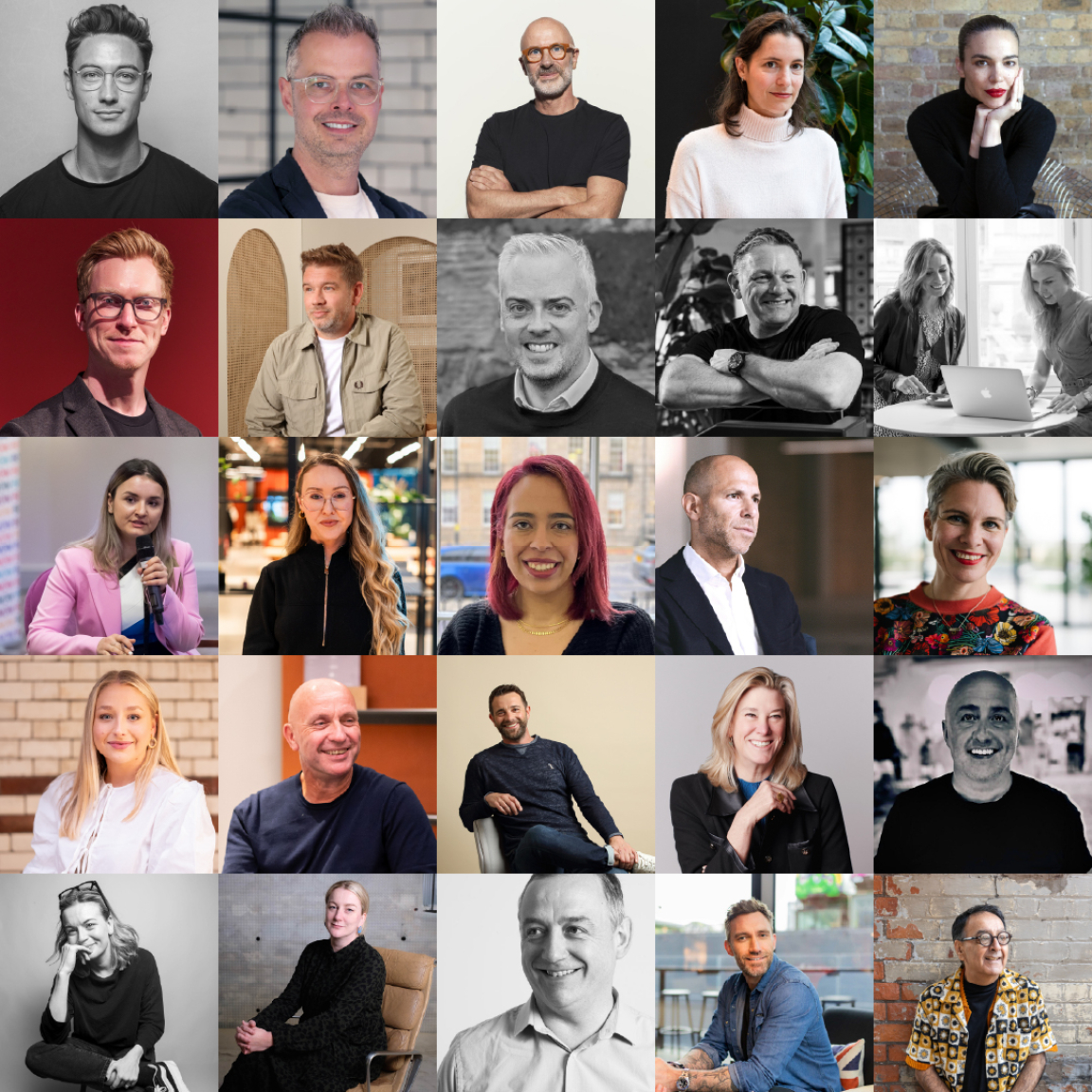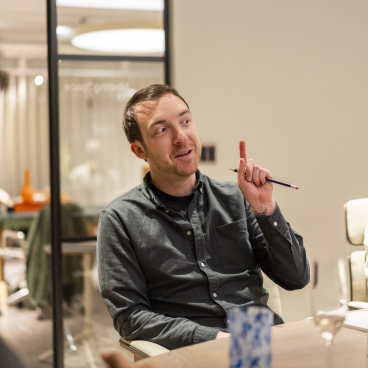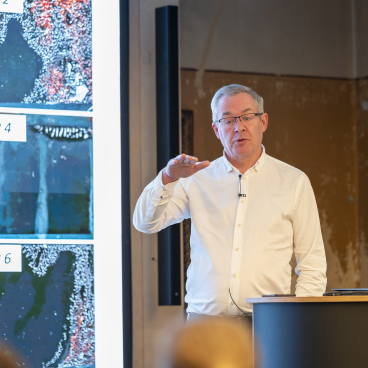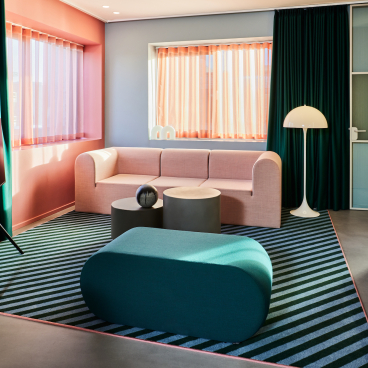2025 Forecast: 25 views from industry leaders in architecture, design & property.

By way of forecasting what may be to come, we asked you – our community – to let us know what 2025 looks like for you, and, more generally, the sector.
From the challenges we may collectively face, to your hopes, aspirations, and the things you would most like to change if you could, across the 25 responses, four unprompted themes emerged.
Sustainability, EDI, the impact of technology, and property and building regulations – the factors most important to you sync exactly with the topics we will cover through our editorial and events programme for next year.
Without further ado, here are your comments in relation to your expectations for the year ahead – a huge thank you to all who’ve taken part. From here, we’re looking forward to continuing the conversations into the New Year, and beyond, at our seminars, roundtables, exhibitions and online editorial.
True sustainability
Astrid Hugo, senior sustainability specialist, Gensler
“My hope for 2025 is that we continue to take meaningful steps toward addressing the environmental impact of sourcing and production in our industry. The choices we make extend far beyond the end user, and by considering the wider effects of the materials we use, we can create a more sustainable world for all.”
Bikem Korkuter McHugh, interiors lead, Oberlanders
“The rise of universal material passports could be game-changing: with every material carrying its digital history of origin, lifecycle, and recyclability, it would revolutionise our approach to construction and refurbishment. Designers could make more informed choices, and circular economy principles would truly take hold, with a drastic reduction in waste. It will also introduce much more transparency into supply chains for better decision-making.
“I can see it creating a new standard of accountability in which companies and manufacturers are incentivised to design products for longevity and sustainability. In the long-term, it could create a significant shift in our perceptions: from disposable commodities to highly valued, reused assets that support a more sustainable future.”
Atul Bansal, partner & founder, Sheila Bird Studio
“My biggest hope is that the organisations that don’t back up their promises with real action will be left behind. Clients are becoming increasingly savvy and are no longer willing to tolerate empty buzzwords and vague commitments. The sector will be stronger because of it, only the companies that truly deliver on their promises will thrive, while the ones who just talk the talk will fade away.”
Ivor Phillips, director of architecture, Broadway Malyan
“The big things coming at us next year we think can be broadly themed into the three categories of Carbon, Legislative Framework, and, at the other end of the spectrum, Customer Experience. Carbon calculation and carbon reduction is increasingly coming to the fore as clients and investors count the carbon cost of development in accord with emerging regulatory frameworks and policies.
“Similarly, the Building Safety Act is informing design, procurement, and investment decisions on high density residential schemes, with the current backlog of approvals causing issues of uncertainty in development programmes. Finally, the ‘Customer Experience Factor’ continues to build across all sectors with more demanding and stringent end user requirements as the hospitality experience keeps its firm hold on market expectations.”
John Williams, director/founder, SpaceInvader
“Without a doubt, the main influence will continue to be the drive to carbon net zero. Buildings need to achieve net zero in operation, but occupiers in the commercial / workspace zone will also need to change the way they fit-out and occupy spaces when it comes to energy use to ensure landlord targets are met. As designers, seeking to create beautiful spaces, balancing a premium look and feel whilst ensuring legal and desired targets are met in all aspects of functionality will continue to be a major focus.”
Stephen Clarke, director, Flexible Business Interiors
“In 2025, sustainability will be a driving force behind the design of offices. Increasingly, there will be a focus on reducing waste and resource consumption, with initiatives like refurbishing and reusing existing furniture becoming standard practice. This trend reflects a broader shift toward circular design, where materials are reused, repurposed, and recycled.
“In the projects we’ve undertaken this year, we’ve seen an uplift in refurbishment over replacement, reducing environmental impact while maintaining high-quality, functional environments. As businesses strive to meet sustainability goals, eco-friendly building materials, energy efficiency, and waste reduction strategies will increasingly influence the design of future workspaces.”
EDI & experience
Darren Clanford, co-founder & creative director, Material Source
“2025 will be all about experience. People, quite rightly, expect value from the spaces they visit and inhabit, and that’s fuelling the need for all in our sector to think deeply about the individual needs of end users and tailor their product or service to suit. At the same time, the planetary experience must also be considered – sustainability should underpin every decision we make. At Material Source we aim to ‘delight every time’, with Beautifully Useful always at the forefront of our minds. If an idea doesn’t hit both points then it won’t offer the experience you deserve, and therefore, it’s not sustainable. It’s provided us a great measure so far, and is what will take us into 2025 and beyond.”
Becky Spenceley, design director, Gensler
“I believe we are on the precipice of immense change in the design and construction industry. For 2025, I’d like to see our design teams harnessing science-backed research and data to create more human spaces that are sensory, inclusive, and neurodiverse. By educating ourselves with a greater understanding of human needs, both physiologically and emotionally, we can craft connected, authentic and purposeful environments that support a broad spectrum of cognitive needs. Quality, valued space should be truly accessible for everyone.”
Eleanor Strange, architect, AEW
“In 2025, I hope inclusive design takes centre stage across all built environment sectors, evolving to become a fundamental design principle. Inclusive design benefits everyone, not just specific groups, and is rooted in understanding user diversity to create spaces that are accessible, welcoming, and empowering for all.
“The progress and conversations around inclusivity in 2024 have been encouraging, and I hope this momentum continues. By prioritising informed design decisions and maintaining open dialogue, our sector can lead the way in creating environments that foster equity, well-being, and happiness for all users.”
Catalina Ionita, senior architect, Chapman Taylor
“If I were Prime Minister for a day in 2025, I would organise a Design Charette, bringing Westminster to Blackpool for a day trip.
“The UK can only evolve as a united nation by addressing disparities in opportunity and creating high-quality places for those disproportionately disadvantaged. The Design Charette, hosted in the iconic Blackpool’s Winter Gardens, would focus on collaboration—uniting policymakers, local leaders, and community representatives to share lessons, confront challenges, and pursue shared goals.
“The country faces long-standing issues like climate change, economic shifts, and an ageing population. To tackle these effectively, we need to rebalance the local-national relationship. National government must work closely with trusted local leaders to deliver transformative change, empowering people, and families with the best opportunities.
“Currently, UK governance often feels like a distant pyramid, with citizens at the base and central government at the peak. This disconnect disincentivises public engagement and limits the government’s ability to understand and address the diverse experiences across the country. Local government, deeply rooted in communities and businesses, is uniquely positioned to support better policymaking. Councillors, as democratically elected representatives, are the backbone of local democracy. Their decisions directly shape people’s wellbeing and prosperity, and it’s crucial to strengthen this vital layer of governance.
“By prioritising collaboration and amplifying local voices, we can nurture and evolve a more balanced, inclusive, and effective governance system—one that works together to level up opportunities and create a better future for all.”
Victoria Firth, co-CEO, Grey Lemon
“We hope business leaders are brave enough to take an honest look at their organisations and face up to the reality of their current circumstances. You can’t approach 2025 doing the same thing and expect different results. Identifying and understanding the brutal truth of your situation is crucial.
“If you’ve veered off track, refocus and get clear on your purpose and objectives. Know what you’re trying to do and be clear on how you’re going to get there. Ensure your team is with you on the journey – engaged, committed and clear on their role in driving the business forwards.”
Annabelle Brading, architect, Sheppard Robson
“For me personally, I would love to see further development when it comes to designing safe spaces for women. I would love to see a world where women feel safe to run, safe to work late, safe to walk their dogs in winter and we as designers are directly responsible for how we create and activate our spaces.
“Beyond this, I would love to see all corners of the construction industry bursting with a female presence, where we are celebrated for our intuition, empathy, bravery and leadership.
“If the medical industry can finally recognise that women have been left out of the picture for far too long, then my greatest hope is that when we in the construction industry design spaces we engage in conversations that push designs to better the lives of our women and girls.”
Simon Millington, founder, Incognito
“As we come to the end of 2024 – a year of transition and global uncertainty – we are already seeing a trend towards stronger decision making which will drive an uplift in the market in 2025 as we see pent up demand for a new generation of workspaces come into fruition. These spaces will prioritise low carbon footprints, integrating sustainable materials and energy-efficient technologies.
“At the same time, designs will focus on enhancing human well-being, incorporating advanced tech for seamless connectivity, and fostering collaboration. Flexibility, resilience, and adaptability will be key, ensuring buildings can respond to evolving needs and create environments that reward both productivity and health.”
Jasper Sanders, founder, Jasper Sanders + Partners
“In 2025, design will be influenced by a growing desire for authenticity and connection. As people seek refuge from the digital saturation of AI and social media, they’ll yearn for spaces that feel grounded, human, and soulful. Buildings and interiors will increasingly reflect the unique needs and personalities of their users, emphasising warmth, texture, and real materials.
“The focus will shift towards designs that evoke genuine experiences—spaces that feel tactile, earthy, and relatable, rather than polished, artificial constructs. This humanised approach will prioritise emotional connection, creating environments that resonate deeply with those who inhabit them.”
Michael Rogan, co-founder & director, Material Source
“Our entire business at Material Source is built around ‘the experience’, and we can't do this without great people. Our focus in 2025 is to work with partner brands to deliver 'new' and useful. This will continue to be at the heart of all that we do by enabling our team to provide a world-class experience for our visitors to the studios, online, and collaborating with partners to show material and product innovation that contributes positively to a more sustainable built environment. There is genuine excitement about what we have in store for 2025!”
AI & technology
Kay Sargent, senior principal, HOK
“Work-life is different today than they were 40 years ago, and it is becoming unsustainable. People are living longer hence they will need to work longer. 60+ year careers could be the new norm. Our obsession with technology is taking away from the human experience. And we are increasingly multi-tasking while on back-to-back calls, which is eroding the quality of work product and increasing burnout and disengagement.
“Companies need to reconsider how to make elongated careers sustainable, how to upskill the workforce and create fit-for-purpose places - with structured time together and away - designed for specific outcomes. If AI can significantly increase productivity, let’s go to a 4-day work week and introduce sabbaticals to help people thrive.”
Steven Charlton, founder & CEO, i/o atelier
“In 2025, we’ll see an explosion of AI tools integrating into the design process. My hope is that our industry leverages this opportunity to boost profits, reduce overtime, and combat burnout, while unlocking new levels of creativity. This is a chance to reimagine how we work—using technology to empower talent and foster innovation.
“However, we must avoid the pitfall of racing to the bottom with short-term thinking. Instead, we should embrace AI as a force for sustainable growth and meaningful progress, ensuring this generational opportunity transforms our industry for the better."
David McGowan, director, Corstorphine & Wright
“We are only just beginning to grapple with the challenges and opportunities that big data presents to our industry. Whether it’s harnessing insights from our existing built environment, analysing user behaviours in real time, or mapping the day-to-day workings of the buildings we inhabit, the potential is an interstellar sized mind boggle.
“Technology enabling us to leverage this data, from design testing to analytical understanding, it is advancing at lightspeed. While we don’t yet fully understand how it will reshape design, coordination, construction monitoring, or building operation, one thing is certain: the future will demand adaptability and an openness to redefine the way we work.”
Natasha Bonugli, founder & creative director, The Bon Collective
“In 2025, the interior and built environment sector will continue to face several significant challenges. Supply chain disruptions will persist, causing material shortages, rising costs, and delays, pushing designers to explore alternative sourcing and localised supply chains. Labor shortages, driven by an aging workforce and difficulty attracting younger professionals, will limit the ability to meet growing demand for new and renovated spaces.
“Additionally, as smart building technologies and AI-driven design reshape the sector, integrating these innovations into existing infrastructure will be complex. Addressing these challenges will require strategic adaptation, collaboration, and investment in technology and workforce development.”
Rachel Withey, founding partner, Ekho Studio
“My greatest hope for interior design in 2025 is to witness a truly harmonious integration of AI tools that amplify, rather than replace, human creativity and collaboration. While AI undoubtedly offers incredible potential for streamlining processes and enhancing efficiency, it's crucial we don't lose sight of the heart and soul of design: that spark of imagination, the joy of sketching concepts on paper, and the magic that happens when minds come together. Let's see more pen on paper, more face-to-face interactions, and more spaces that tell a story.”
Property targets & regulation
Nick Atkin, CEO, Yorkshire Housing
“2025 will be a pivotal year for housing - action and funding are vital. The Government’s long-term plan for housing and Spending Review are expected in Spring. Housing must be linked to economic growth, with an AHP underpinned by a 10-year rent policy.
“Reclassifying housing investment as national infrastructure, on a par with road and rail projects, would unlock strategic sites, increase investment, and support the Government’s 1.5 million homes pledge. Decarbonisation will accelerate with the Warm Homes Programme, but more than the £1.29 billion pledged is needed.”
Daniel Austin, CEO and co-founder, ASK Partners
"I think in 2025 we will see even more inspirational design in the built environment. Changes in the way we work and spend our time since the pandemic have prompted demand for more dynamic and flexible accommodation. Alongside these changes, we are seeing an increase in regulations for environmental standards. Together these factors will continue to drive developers to work with architects and designers to create vibrant aesthetics, and form and function which exceed new industry standards in emerging models such as co-living and build-to-rent. And as more buildings become obsolete, we will continue to see the trend for repurposing and value-add investment opportunities.
“Those that have a clear business plan and the vision to enhance the value of their asset by exceeding expectations and market demand will play a key role in reshaping UK real estate in 2025. However, inflationary pressures and supply chain volatility will continue to increase material and construction expenses. Balancing these hurdles while leveraging growth opportunities in adaptive reuse and sustainable developments will define success in this evolving market landscape.”
Greg McCallum, senior associate, Hollis
“Two of the biggest challenges next year relate to housing. The government’s recently announced Remediation Acceleration Plan sets a clear target for 2029, with building owners under pressure to address cladding issues after years of inaction. Retrofitting homes to improve energy performance is overdue too.
“We’re going to need more skilled workers to meet this demand, and government support is likely to be needed for both.
“Unfortunately, a backdrop of economic uncertainty is constraining budgets and affecting confidence. The new government is giving some signs of hope, but there is still hesitancy as people wait to see what happens.”
Shannon Conway, co-founder, Picture This
“There is much conversation around how we solve the impending crisis of housing our ageing population. As prime minister in 2025, the first step I would take would be to ensure all new homes are designed to suit all ages, meaning people can remain in their own home, living within mixed, multigenerational communities as they get older.
“All new homes would be required to be designed to Lifetime Homes standard which means they would be easily adaptable and accessible. This would allow people of all ages and abilities to stay in their own homes for longer without the need for major modifications.”
Jamie Hanson, director, CODA
“We probably sound like broken records, but we are still concerned about; new regulatory reform and the timescales to achieve BSA approval on HRBs, planning and viability of schemes. Regulatory reform is the main driver, especially around High Risk Buildings.
“We believe that the sector will get to grips with Gateways 1-3 and information required for submissions, therefore making the process more streamlined. The benefit of the legislation for safer and better-quality buildings will be seen.
“A curveball could come in around the political narrative - the need to increase house building and the development of critical infrastructure Britain needs for its future has become much more positive and proactive since Labour took office. The voice of the builder has been elevated whilst that of the NIMBYs and the blockers has been diminished somewhat.
"Whether this will help translate into a better year for development in 2025 remains to be seen, however a more positive agenda backed up by political support to get ‘Britain Building Again’ is to be welcomed.”
Have you got a view to add? Let us know! And if you’re not already signed up to attend the first Seminars in our 2025 programme on Sustainability, click here for Manchester tickets, and click here for Glasgow tickets. The rest of the dates and panellists will be released in the New Year. Stay tuned.
Thanks again to our 25 commentators, and to everyone who has supported Material Source in 2024 - here's to a bright and prosperous 2025.
Photography credits: Lucy McKenzie, Tim Ainsworth, Victoria Middleton, Pip Rustage




